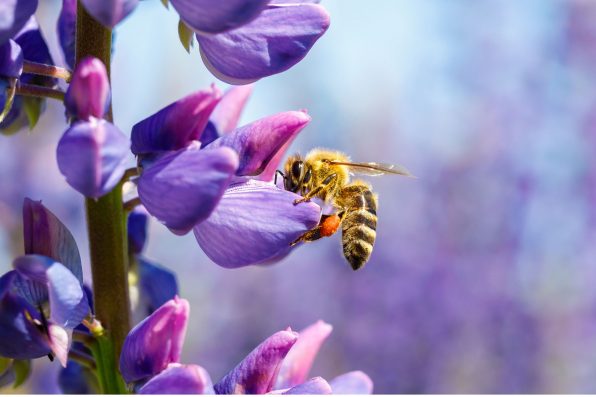New Research Suggests That Air Pollution Is Diminishing The Natural Scents Of Wild Plants And Making Them Less Attractive To Pollinators, A Consequence That Can Have Far-Reaching Implications For Our Environment

Rising sea levels, tumultuous weather patterns, and a rising frequency of natural disasters are all known results of burning fossil fuels. But, researchers have uncovered another, more unexpected consequence of climate change: the loss of earth’s natural, rich aromas.
A recent study suggests that continuous emissions from factories, vehicles, and other industrial activities are altering and diminishing the natural scents of wild plants. These fragrances are crucial for drawing in pollinators.
The team of nine behind the study examined the scent-based relationship between primroses, which are night-blooming wildflowers, and hawk moths, which are nocturnal insects that are attracted to the flower’s fragrance.
This research revealed that common air pollutants like ozone and nitrate radicals greatly weaken the fragrance of these wildflowers. This reduction in scent makes the moths less likely to visit plants in polluted areas.
“We worry a lot about exposure of humans to air pollution, but there’s a whole life system out there that’s also exposed to the same pollutants,” said Joel Ston, the study’s co-author and atmospheric chemist.
“We’re really just uncovering how deep the impacts of air pollution go.”
The research team visited a site in eastern Washington where primroses were growing and collected air samples with the flower’s scent using plastic bags. Then, in the laboratory, they broke down this fragrance into 22 distinct chemical elements that could potentially appeal to hawk moths, which are known for their highly sensitive antennae.
According to Jeff Riffell, another co-author of the study and a sensory neurobiologist, hawk moths are “good as a dog” when it comes to chemical sensitivity.
The researchers assessed the electrical responses in the moths’ antennae to identify which aspects of the primrose scent were most appealing to the insects. They discovered that monoterpenes, compounds present in numerous fruits and vegetables and known for imparting distinctive aromas to bark and coniferous leaves, were particularly favored by the moths.

natali_mis – stock.adobe.com – illustrative purposes only, not the actual bee
These insights enabled the researchers to concoct a synthetic version of the primrose scent and then taint it with chemicals to mimic a flower affected by typical air pollutants.
The addition of just ozone reduced the concentration of monoterpenes in the fragrance by roughly 30%. However, when they introduced nitrate radicals, which are predominantly active at night when hawk moths are active, the levels of these sweet-smelling monoterpenes plummeted by a whopping 84%.
The diminishing strength of the fragrance resulted in two species of hawk moths showing less interest in the artificial primrose.
In a controlled wind tunnel experiment, the researchers placed a faux flower infused with the synthetically polluted primrose scent. They observed that, compared to a natural primrose in the same wind tunnel, the tobacco hawk moths reduced their visits by 50%, while the white-lined sphinx moths completely ceased visiting the altered flower, showing a 100% decrease in visitation.
In response to these findings, Ilaria Negri, a zoologist who did not participate in the study, claimed that “Pollinators are literally starving.”
“That pollinators are unable to find already scarce food due to pollution is challenging for many species,” Negri said.
The scientists found that when they introduced their artificial flower, mimicking a pollution-affected primrose, into a field of healthy primroses, hawk moths were 70% less likely to visit the imitation over the course of one night compared to the natural flowers.
This decline in visits, they note, would result in the primroses producing 28% fewer seeds.
Furthermore, the researchers developed computer simulations to examine how fragrances would have interacted with the atmosphere before industrialization.
Their findings indicated that, due to the current levels of air pollution in most urban areas globally, the distance at which pollinators such as hawk moths can detect scents has been reduced by as much as 75% since preindustrial times.
These results highlight the effects of “sensory pollution,” which refers to human-created disturbances that disrupt animals’ sensory perception.
Some examples of this include artificial lighting that can confuse insects and migratory birds and noise pollution from cars, airplanes, and ships that can impair hearing in aquatic species and disrupt the reproductive behaviors of various animals.
The study’s findings also indicate that pollutants have an impact on animals’ olfactory senses. Should other pollinators respond to pollution similarly to hawk moths, it could have far-reaching consequences.
This includes potential effects on agricultural productivity, biodiversity, and the intricate ecosystems of insects, which play a vital role in maintaining the well-being of humans and other wildlife. The reduction of natural scents could significantly influence all of these areas.
“It’s just more motivation for moving our transportation and energy needs away from fossil fuel combustion and to other sources of energy,” concluded Thornton.
To read the study’s complete findings, which have since been published in Science, visit the link here.
Sign up for Chip Chick’s newsletter and get stories like this delivered to your inbox.
More About:Science





